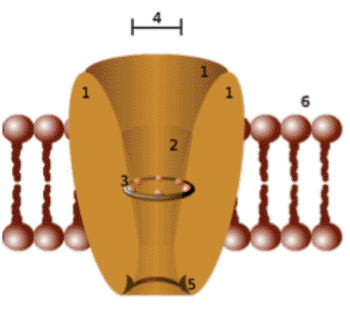Microsystem Reduces Cost of Developing Ion Channel Drugs
By LabMedica International staff writers
Posted on 11 Dec 2013
The use of a microsystem that generates ion channels in a cell-free medium is expected to boost development of drugs that target these channels in the treatment of diseases such as cystic fibrosis, myasthenia gravis, and epilepsy.Posted on 11 Dec 2013
The effect of drugs on ion channels is currently studied by electrophysiology, which measures an electric current across ion channel proteins. This, however, is a slow and expensive process that is carried out using ion channels in living cell membranes.

Image: Schematic diagram of an ion channel. 1 - channel domains (typically four per channel), 2 - outer vestibule, 3 - selectivity filter, 4 - diameter of selectivity filter, 5 - phosphorylation site, 6 - cell membrane (Photo courtesy of Wikimedia Commons).
In a paper published in the October 18, 2013, online edition of the journal Analyst, investigators at the University of Southampton (United Kingdom) in collaboration with colleagues at the University of Quebec (Montreal, Canada) described the development of a cell-free expression mixture that allows ion channels to be inserted into stable artificial "cell membranes."
Results of the study showed that single-channel current measurements of the potassium channels KcsA and hERGS5–S6 could be obtained by direct insertion in interdroplet lipid bilayers from microliters of a cell-free expression medium.
"By putting the ion channel into an artificial membrane, we only have one type of channel, no living cells, and a relatively inexpensive method for testing for several of these types of channels at once," said senior author Dr. Maurits de Planque, lecturer in electronics and computer science at the University of Southampton. "Researchers have experimented with cell-free mixtures before, but they found that this method was not economical due to the amount of expensive biochemicals required. Our proposal to develop a new platform, which uses a couple of microliters instead of milliliters, will be a very cost-effective way of doing this, particularly when the produced channel is directly inserted in a membrane for drug testing."
Related Links:
University of Southampton
University of Quebec














